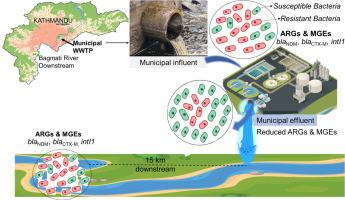从尼泊尔城市污水处理厂和城市河流中分离出碳青霉烯酶和广谱β-内酰胺酶产生细菌
IF 5.8
Q1 MICROBIOLOGY
引用次数: 0
摘要
城市污水处理厂(WWTPs)和接收污水的河流是已知的抗生素耐药细菌(ARB)的热点,其中含有各种抗生素耐药基因(ARGs)和移动遗传元件。然而,携带多种抗性基因的ARB在加德满都城市污水处理厂及其接收河流中的具体分布尚不清楚。因此,本研究调查了从城市污水和河水中分离的产碳青霉烯酶和广谱β-内酰胺酶(ESBL)细菌中耐药菌群的比例以及各种ARGs和整合子的存在。与未经处理的污水相比,经处理的城市污水中水的物理化学特性得到改善,ARB和抗生素耐药性决定因素显著减少。232株分离菌中,34.82%为碳青霉烯酶产生菌,42.50%为ESBL产生菌。大肠杆菌和肺炎克雷伯菌是产碳青霉烯酶和esbl的主要细菌,在未经处理的城市污水中丰度最高。产碳青霉烯酶菌中blaNDM和blaOXA基因较多,而产esbl菌中blaTEM和blaCTX-M基因较多。这些细菌分离物中近一半携带intI1基因,表明其在ARGs传播中的作用。这些发现强调了污水处理厂在去除化学和生物污染物方面的关键作用,强调了它们在城市生态系统适应中的重要性。然而,ARB中多个耐药基因和整合子的同时存在导致了环境中抗菌素耐药性的上升,强调需要有针对性地努力管理和减轻耐药因素的传播。本文章由计算机程序翻译,如有差异,请以英文原文为准。

Carbapenemase and extended-spectrum β-lactamase producing bacteria isolated from municipal wastewater treatment plant and urban river in Nepal
Municipal wastewater treatment plants (WWTPs) and rivers receiving sewage are known hotspots for antibiotic-resistant bacteria (ARB), harboring a wide variety of antibiotic resistance genes (ARGs) and mobile genetic elements. However, the specific distribution of ARB carrying multiple resistance genes in municipal WWTPs and their receiving rivers in Kathmandu remains unclear. Therefore, this study investigated the proportion of antibiotic-resistant bacterial populations and the presence of various ARGs and integrons in carbapenemase- and extended-spectrum β-lactamase (ESBL)-producing bacteria isolated from municipal wastewater and river water. The improvement in water’s physicochemical characteristics and a significant reduction in ARB and antibiotic resistance determinants were observed in treated municipal wastewater compared to untreated wastewater. Among 232 bacterial isolates from these samples, 34.82 % were identified as carbapenemase producers, while 42.50 % were confirmed as ESBL producers. E. coli and K. pneumoniae were the predominant carbapenemase- and ESBL-producing bacteria, with their highest abundance in untreated municipal wastewater. Among carbapenemase-producing bacteria, blaNDM and blaOXA genes were more prevalent, whereas blaTEM and blaCTX-M genes were commonly detected in ESBL-producing bacteria. Nearly half of these bacterial isolates carried the intI1 gene, indicating its role in the dissemination of ARGs. These findings underscore the critical role of WWTPs in the removal of chemical and biological pollutants, highlighting their significance in urban ecosystem-based adaptation. However, the simultaneous presence of multiple resistance genes and integrons in ARB contributes to the rising antimicrobial resistance in the environment, emphasizing the need for targeted efforts to manage and mitigate the spread of resistance factors.
求助全文
通过发布文献求助,成功后即可免费获取论文全文。
去求助
来源期刊

Current Research in Microbial Sciences
Immunology and Microbiology-Immunology and Microbiology (miscellaneous)
CiteScore
7.90
自引率
0.00%
发文量
81
审稿时长
66 days
 求助内容:
求助内容: 应助结果提醒方式:
应助结果提醒方式:


